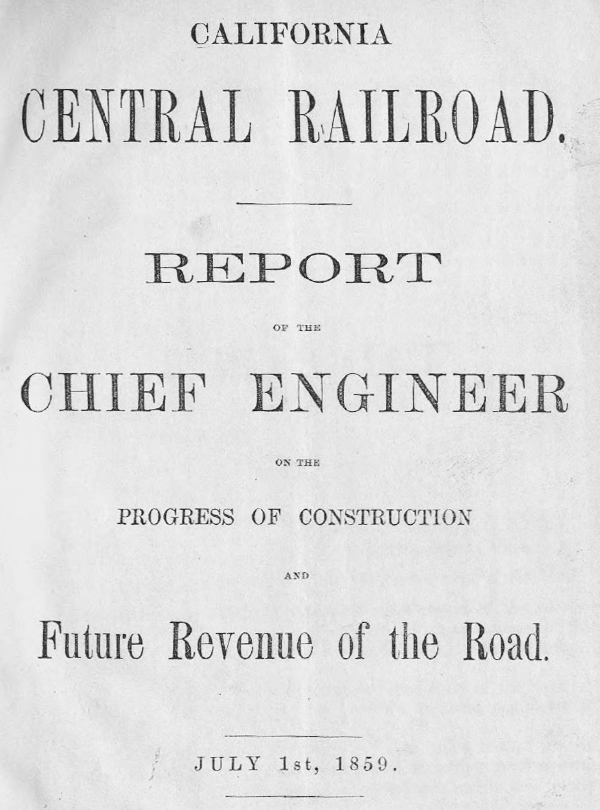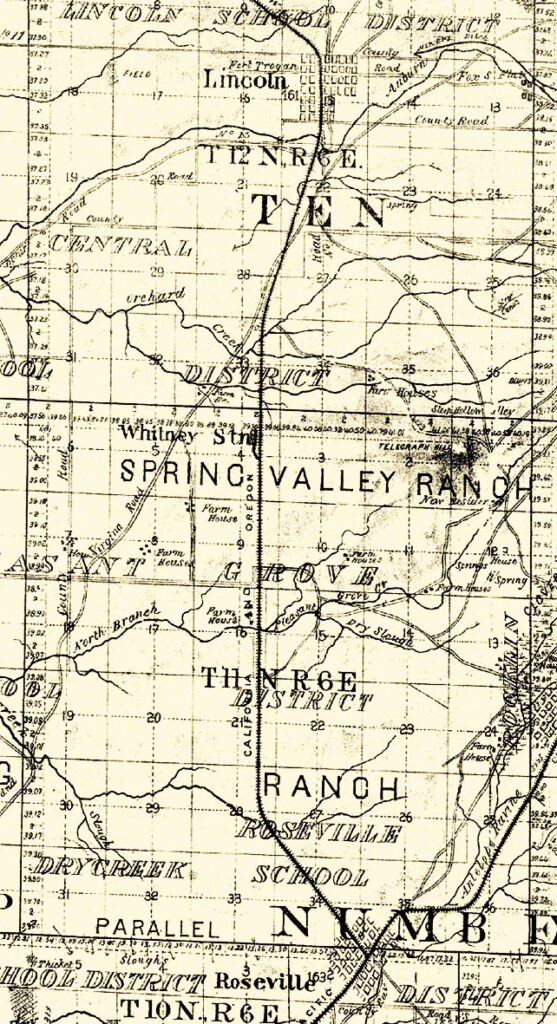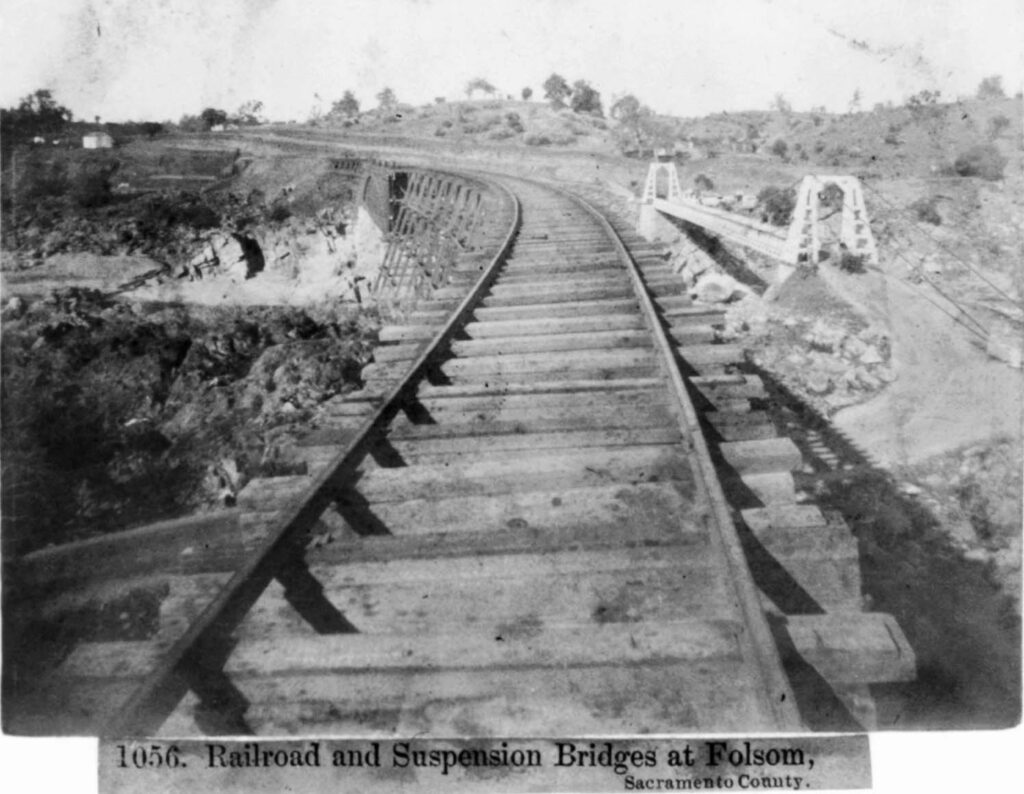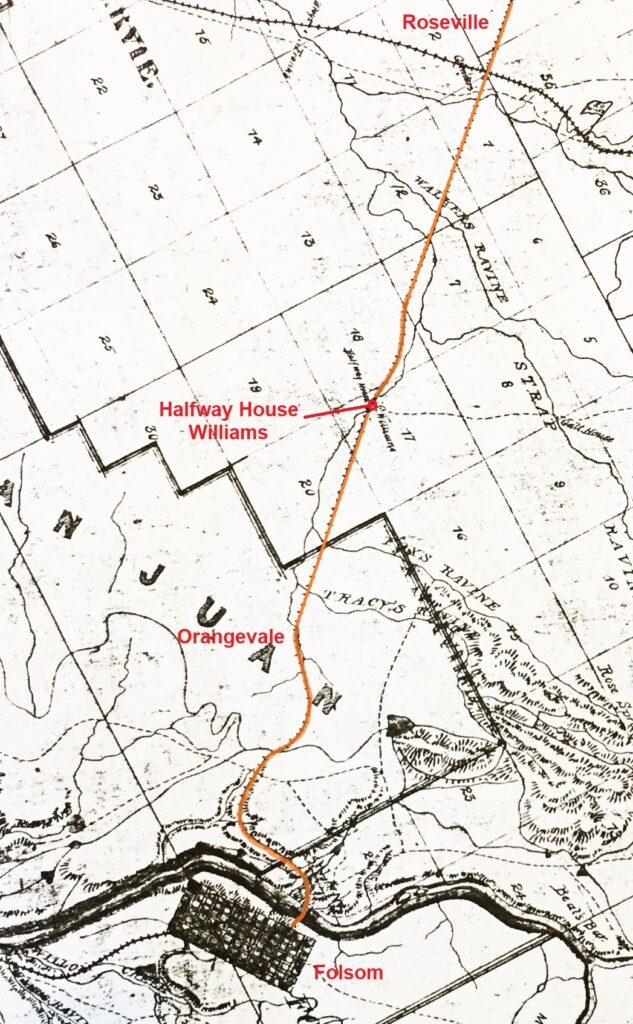Theodore Judah’s 1859 report on the progress of the California Central Railroad provides a glimpse of the work that would have the rail line cross through present day Folsom, Orangevale, and Roseville. The California Central Railroad had plans to lay track from Folsom up to Marysville. By the summer of 1859, the first 5 miles of railroad was nearly complete to Williams. Judah was confident that the contractor would finish the line up to Nevada Station by the end of the year.

Judah’s 1859 Report on the Folsom, Orangevale, and Roseville railroad Progress
As part of Judah’s report was a forecast of revenue and expenses for the railroad. As a foundation for his optimistic economic analysis, Judah included revenue and expenses for the Sacramento Valley Railroad that operated from Sacramento to Folsom.
Below is a transcription of Judah’s report, slightly edited for space and conversion of some of the tables for revenue and expenses. After the transcribed report is a letter from the contractor to Judah.
Some of the locations cited in the report have disappeared or had the names changed.

Williams was also known as the Halfway House on the Sacramento and Auburn Road. It was just south of the intersection of Old Auburn Road and South Cirby. Judah obviously anticipated that Williams would be a railroad stop for passengers and freight traveling between Sacramento and Auburn.
Antelope Ravine is Dry Creek as it flows toward Royer Park in Roseville.
Lost Creek and Branches were creek crossings north of Roseville. I have yet to specifically identify the current names of the creeks.
Nevada Station is Lincoln. Judah had envisioned there would be an extension of the railroad up Auburn Ravine to the town of Auburn at this location.
Russville became Ashland, a small community on the northside of the American River across from Folsom.

California Central Railroad.
Report of the Chief Engineer on the Progress of Construction and Future Revenue of the Road.
July 1st, 1859
[page 3]
Report.
Engineer’s Office, C.C.R.R., Sacramento, July 1, 1859.
To the President and Directors of the California Central Railroad:
Gentleman: Herewith I present a brief report of the present state of progress of grading upon your Road, with an estimate of the amount of work remaining to complete the first Division to the Auburn Ravine or Nevada Station.
My report of Dec. 31, 1858, presented the state of the work at that time, and an estimate of its probable revenue completed to Marysville.
The work upon the first sub-Division of five miles, at that time in an unfinished state, is now entirely completed, including the American River Bridge, the Trestling and small structures, and is now ready for the track.
The second sub-Division of thirteen miles is rapidly progressing under the sub-contract of Messrs. Chenery, Binney, Houston and Nagle. It is to be entirely finished before Dec. 31, 1859. There are about 95,000 cubic yards of material remaining to complete this division, distributed that a large force can be advantageously employed in its excavation and removal.
[page 4]
Structures.
The remaining structures are comparatively light and unimportant. They consist of
6 Trestle Bents at Antelope Ravine Crossing.
6 Trestle Bents at Auburn Ravine Crossing.
4 Trestle Bents at Dry Creek Ravine Crossing.
4 Trestle Bents at Lost Creek and Branches.
4 Trestle Bents at Lost Creek and Branches.
4 Trestle Bents at Lost Creek and Branches.
4 Trestle Bents at Pleasant Grove Ravine.
2 Trestle Bents at Orchards Creek.
2 Trestle Bents at Orchards Creek Branch.
All in spans of 18 feet, and varying from 6 to 24 feet in height.
There are also 20 stone or blind drains, containing about 250 cubic yards, remaining to complete.
Summary of Quantities Necessary to Complete the Line from Folsom to Auburn Ravine.
95,000 cubic yards of excavation.
185,000 feet of time in structures
15,000 lbs. of iron in structures.
250 cubic yards of stone in blind drains.
Ties
The Ties for this division are all under contract – 30,000 of them are out and ready for shipment, and the balance will be ready for delivery as called for by contract.
Iron Chairs and Spike.
A portion of the Iron Chairs and Spike are already delivered in San Francisco; the balance is all purchased, shipped, and now on its way here.
Cars, &c.,
Are also purchased, shipped, and on the way to San Francisco.
Estimated Revenue of Road Completed to Auburn Ravine.
In my report of Dec. 31st, 1858, will found a careful estimate of the amount of business accruing to your Road when completed to Marysville, prepared from statistics of then existing travel, and obtained in a reliable manner. Subsequent observations confirm the correctness of these statistics, showing conclusively that a concentration
[page 5]
of this travel upon your road will create a business, which will in point of profitableness render your Road second to none other in the United States.
In estimating the business of your Road, completed and running to Auburn Ravine, I have thrown out the Marysville travel, and count upon business derived from the following sources: –
1st. Passengers and freight passing over the Sacramento Valley Railroad via. Folsom, destined for the Placer and Nevada counties.
2d. Passengers and freight to and from these counties by teams and stages direct.
3d. Riders, footmen, and ranchmen.
4th. Local travel.
5th. Return freights.
6th. U.S. Mails and Express business.
1st. From the inspection of the statistics, it will be seen that the number of passengers destine for the Placer and Nevada counties, via. The S.V.R.R.:-
Average daily by stage, each way….35 passengers.
Average daily by wagons, each way….10 passengers.
Average daily by footmen, each way.…8 passengers.
Making a total number, each way, of 53 – or both way, 106 per day.
Freights, average daily ….10 tons to Russville.
Freights, average daily…. 10 tons to Placer and Nevada counties.
Making a total of 20 tons each way, or a total of 40 tons per day.
2d. The number of passengers by wheeled vehicles, direct from Sacramento to Placer and Nevada counties, is estimated at 25 each way, or a total of 50 per day.
Freights by loaded teams direct from Sacramento, are found by actual count to equal 186 tons of out freight.
In order to confine the estimates within safe limits, outward freight is estimated at 180 tons, including local and Bear River freight.
5th. Return freights will consist principally of lumber and wood, and are estimated at 100 tons per day.
6th. Mails and Express are estimated at $15,000 per year.
Recapitulation. Passengers.
Pass./day Pass./year From To Miles Fare Amount
10 3,130 Folsom Williams 5 $0.50 $1,565.00
10 3,130 Williams Folsom 5 $0.50 $1,565.00
80 25,040 Folsom Nevada Sta. 18 $1.50 $37,560.00
80 25,040 Nevada Sta. Folsom 18 $1.50 $37,560.00
Russville travel $2,000.00
180 56,340 Total Passenger Receipts $80,250.00
[page 6]
Freight.
Tons/day Tons/yr. From To Miles Rate Amount
10 3,130 Local $1.50 $4,695.00
200 62,600 Folsom Nevada Sta. 18 $2.00 $125,200.00
Russville freight $2,000.00
100 31,300 Return freight $1.50 $49,950.00
310 97,030 Total Freight Receipts $177,845.00
Summary
Receipts from passengers…. $80,250.00
Receipts from freight…. $177,845.00
Receipts from Mails and Express…. $15,000
Total Receipts…. $273,095.00
Deduct all expenses…. $70,000
Leaves as net earnings ….. $203,095.00
Deduct interest on $600,000 of mortgage bond at 8 per cent…. $48,000
Deduct sinking fund to redeem mortgage bond…. $15,000
Leaves for dividends on stock…. $140,095.00
Or, about twenty-three per cent. per year on $600,000 of stock
The business of the Sacramento Valley Railroad has steadily increased from year to year, and while its operations afford some indication of the business of your road, its costs of operating and maintenance, furnish certain data, whereby to arrive at the expense of operating railroads in California.
Through the kindness of J.P. Robinson, Esq., Superintendent of the S.V.R.R., I am enabled to present a statement of the actual earnings of that Road for four years, with a statement of the cost of operating and maintaining the same, in detail, showing the proper amount chargeable to each department. This will be found of no little interest and value, as showing not only the comparative yearly earnings of the first road ever built here, but affording certain data whereby to estimate the cost of operating railroads in this State.
It is, however, to be observed that the two Roads can be operated together, at an expense considerably less than the aggregate amount assigned to cover the expense of operating each separately. Should they therefore be run together under a satisfactory arrangement, the net earnings of your Road ought to be increased from $20,000 to $25,000 per year from this cause.
[page 7]
S.V.R.R. Office, August 15, 1859
T.D. Judah, Esq., Chief Engineer C.C. R.R.
Sir: Below you will please find a summary of Earnings and Expenses of the Sac. Val. R.R. for the first four years of its operation, viz:
Account 1856 1857 1858 1859
Earnings $173,434 $178,187 $190,436 $202,191
Expenses M&O $87,483 $87,464 $80,886 $91,074
Net Earnings $85,950 $90,723 $109,550 $111,117
Expenses in Detail.
1856 1857 1858 1859
Passenger Tran. $11,464 $10,726 $9,702 *
Freight Transport. $13,336 $18,169 $20,183 *
Office Expenses $998 $684 $1,006 *
Salaries $12,260 $13,927 $14,400 *
Legal Expenses $674 $1,794 $1,764 *
Taxes $5,999 $5,735 $3,379 *
Contingencies $875 *
Freight Commissioners
Mail Transportation
Work Shop Account $53 *
Street crossings $498 $606 $146 *
Passenger Reclm. $24 $62 $467 *
Freight Reclama. $270 $277 $430 *
Depot Exp. Sac. $2,018 $1,590 $1,452 *
Depot Exp. Folsom $26 $351 $472 *
Engine Repair $20,885 $9,329 $5,958 *
$4,285 $5,178 $4,703 *
$868 $1,240 $1,871 *
Track Repair $20,885 $9,329 $6,052 *
Bridges, Culvert Repair $1,018 $621 *
Fuel Consumed $4,872 $7,753 $6,266 *
Oil Consumed $857 $526 $1,114 *
*I have taken the actual earnings and expenses for seven months, and for the balance of the year, of five months, have taken it from 1858, to make up the appregate (sic) for 1859.
J.P. Robinson, Superintendent.
From this statement it will be seen that every item of expense, including taxes, legal and office expenses, and repairs of every kind, are included in the statement of expenses, while its receipts have increased $12,000 per year for the past two years.
When it is considered that 186 tons of freight per day pass out of Sacramento, on wagons, destine for the counties your Road is intended to supply (none of which now goes over that Road), it will be readily seen that while your Road must perform a heavy freighting business, it will bring to their Road a new business, which must very nearly, if not quite, double its net revenue.
Very respectfully, Theodore D. Judah, Chief Engineer C.C.R.R.
1859 Letter to Theodore Judah on California Central RR Construction
CCRR Camp at Lost Creek, October 12th, 1859
J.D. Judah, Esq.
Dear Sir, We are now at work upon the last cut that has been cross sectioned or upon which the depth of cutting has been marked. After tomorrow we will have no work for our wheel barrow gangs, until the road shall have been further “laid out.” Can you send us an engineer by our team or otherwise. Truly much oblige, From very truly, Chenery, Binney, Houston, & Nagle
The California Central RR would get up and running in 1860. However, Judah’s work to pass the Pacific Railroad Act would ultimately derail the California Central. As the Central Pacific Railroad made its way to Auburn, it opened a more economical route from Sacramento to the mountain gold mining regions. As traffic fell on the California Central, the Central Pacific bought the line and dismantled the tracks in the late 1860s.
California Central Railroad: Folsom to Roseville History



